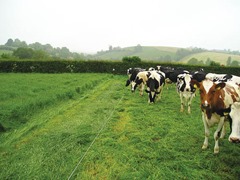Harvest 2020: Can Ireland reach its targets?
 Richard Halleron gathers views from the agri-food industry on how the State’s high ambitions can be met.
Richard Halleron gathers views from the agri-food industry on how the State’s high ambitions can be met.
The world’s population is set to grow by almost 50 per cent over the next three decades from the current figure of 7 billion people up to 9 billion by 2050. Almost all of this growth will take place in the world’s fastest growing economies of Asia.
So not only will we see a tremendous rise in population, the reality is that the burgeoning middle classes in these countries should have the money to invest in diets that contain significantly higher levels of animal protein. In turn, this should be good news for the Irish food industry, which traditionally exports 80 per cent of the dairy, beef and lamb etc. produced in this country. So it was against this backdrop that the Harvest 2020 report – in essence the blueprint for the development for Ireland’s agri-food sectors – was approved by government four years ago.
And so far, so good! The value of Irish food and drink exports approached €10 billion for the first time in 2013, according to figures recently published by Bord Bía. This represents an increase of nine per cent on the previous year and 40 per cent in the past four years with revenues almost €3 billion higher than in 2009. Export values for dairy product and ingredients exceeded €3 billion for the first time and strong performances for meat and livestock (€3.3 billion) and prepared foods (€1.65 billion) all contributed to the positive outcome.
Commenting on these figures, Farm Minister Simon Coveney, said: “Significant growth in 2013 has brought export values in the Irish food and drink sector to record levels. This leading performance, in what was a challenging year for the industry, highlights the key role of agri-food, Ireland’s largest indigenous sector, in underpinning exports and economic activity.
“Export values of almost €10 billion are really impressive, and demonstrate the clear opportunity and benefit of investing in a sector with proven resilience, a significant domestic economic footprint and strong ability to grow. With increasing demand from more affluent consumers in key world markets, there is little doubt that the €12 billion export target set out in the industry-led strategy for the agri-sector (Food Harvest 2020) is well in sight.”
So how will these growth targets be met?
Teagasc management have recently gone public with their thoughts on this matter. They believe that, where milk is concerned, the key development that will impact on the EU dairy sector as whole will be the abolition of dairy quotas in 2015. Teagasc is predicting that dairy cow numbers in Ireland will increase by 333,000 over the next six years. In line with this, milk yields per cow will rise from the current figure of 4,902 litres per lactation up to 5,420 litres by
2020. Significantly, current research performance is averaging at 5,600 litres per cow.
Amongst the performance targets set for the sector during the period ahead is the greater utilisation of grass and forage. Teagasc envisages that herbage utilisation, which currently averages 7.3 tonnes per cow per hectare can increase to 13.2 tonnes. In tandem with this concentrate feeding levels will fall from the current figure of 875 kilos per cow per lactation down to 400 kilos.
Where suckler beef is concerned, Teagasc is predicting a marginal reduction in beef cow numbers. However, this will be balanced by an envisaged increase in the number of calves born per cow per year. Other targets for the suckler beef sector include a reduction in the average calving interval of seven days and total forage utilisation increasing form the current level of 4.7 tonnes per livestock unit up to 6.2 tonnes.
Dairy focus
While Harvest 2020 targets have been set for set for all of Ireland’s agri-food sectors, it is the dairy industry that has received the lion’s share of the media spotlight. This is because an ambitious projection of 50 per cent growth in the volume of milk produced by 2020, compared with the level in 2007-2009 is the game afoot.
Significantly, Teagasc Director Professor Gerry Boyle believes that the milk industry is well placed to meet this target.
Speaking at a recent conference, he explained: “Dairy farmers will be faced with on-farm strategic decisions relating to how this additional milk is produced. It is acknowledged that each farmer faces a different expansion challenges and therefore producers may want to consider various alternative strategies based on their own circumstances in order to meet their own expansion goals.
“It is also recognised that each Irish dairy farmer has different resources available to them, has different values, has a different range of skills, knowledge and aspirations, has a different attitude to risk and has their own definition of success. As a result, there are a number of different approaches taken to milk production currently. Certainly, some of these are based on tradition.
“There is scope for improved efficiency on the majority of dairy farms. Teagasc will work closely with Irish dairy farmers to benchmark progress through the post quota expansion that is imminent. It is acknowledged that expansion challenges will differ from farm to farm, although through collaboration with industry stakeholders Teagasc is confident that a clear and concise expansion strategy can be identified and conveyed to Irish milk producers, so that each farm can adopt the right approach.”
But farmers believe that the Harvest 2020 targets will only be secured on the back of realistic producer returns. In other words, a farming and food chain must be put in place which rewards all the relevant sectors in equal measure.
County Laois suckler beef farmer Jer Bergin takes up the point.
“Farm Minister Simon Coveney must re-focus his priorities when it comes to delivering on the priorities laid down within the Harvest 2020 report,” he says. “The Minister keeps telling us that the agri- food sector will grow tremendously over the next few years.
“But this won’t happen until farmers receive the sustainable prices they need to secure their futures. No farmer in his right mind will look at expansion until the key objective of securing the realistic prices for the food they produce becomes a reality. Once these matters have been addressed, the growth targets laid out for the agri-food industry as a whole will become achievable.”
Not surprisingly, the banks are starting to develop Harvest 2020 investment options for farmers. For its part, AIB has announced a €500 million fund to support the growth and development of Ireland’s agri-sector at farm level.
The fund is designed to support the ongoing development of the farming sector by providing finance for capital expenditure, working capital and asset finance.
It is also available to support farmers who wish to refinance debt from banks that are exiting the Irish market. The fund is supported by discounted EIB funding for eligible projects.
AIB also announced that it has doubled its agri-advisor team to twelve, supporting customers on the ground.
AIB’s Director of Personal, Business and Corporate Banking, Bernard Byrne, said that the announcement demonstrates the bank’s continued commitment to the agri- sector as the industry seeks to realise its enormous potential in the coming years.
“The agri-sector has always been at the heart of our business and indeed the Irish economy. The removal of milk quotas in 2015 presents the dairy sector with a long awaited opportunity to expand,” he commented.
“The investment decisions being made now by farmers are crucial and will have a long-term impact on their future.
“AIB is determined to support the sector by providing both the finance required and the specialist knowledge to help farmers grow and develop their businesses in a planned and sustainable manner.”






